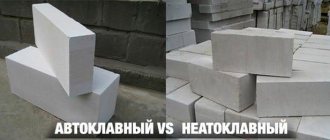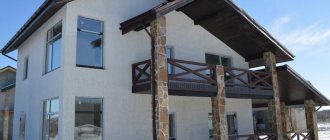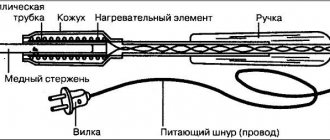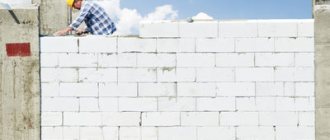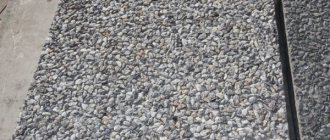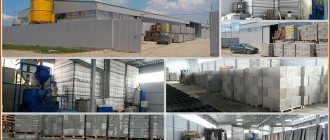Wood concrete is a popular building material with many specific properties and advantages. In foreign countries it has been used for 100 years, but in the domestic space it appeared only in the middle of the 20th century, when private housing construction began to flourish rapidly. Today, the production of wood concrete blocks at home is in widespread demand.
Advantages and disadvantages
Due to its special performance characteristics, wood concrete combines the advantages of 2 building materials.
It can be used as:
- Material for the construction of all kinds of structures.
- Insulating layer.
The solution has both pros and cons, which prevent its use in all areas of construction. The key disadvantage of blocks is their vulnerability to moisture. However, if you plaster the surface outside and inside the building in time, the problem will be eliminated.
pros
Among the key advantages of wood concrete, the following points are highlighted:
- Long service life. Buildings based on such blocks can stand without deformation for more than 100 years, provided that the builders followed all the rules and technological aspects.
- There is no dew point in the material, which eliminates the problem of freezing.
- Easy installation and maintenance.
- Compliance with all environmental standards and requirements.
- Reduced financial costs.
- Possibility of installation on any foundation.
Minuses
The list of disadvantages is relatively small, but it must be taken into account when making wood concrete with your own hands:
- Excessive absorption of moisture due to non-compliance with wood concrete production technology. The material needs good waterproofing, otherwise it will be subject to the destructive effects of high humidity.
- Experts recommend using arbolite-based blocks in regions with prevailing negative temperatures.
Compound
Like any concrete, the material includes a cementitious substance and a filler - only of organic origin, as well as various additives. The origin and properties of the ingredients influence the quality of the final product.
Organic fillers provide wood concrete with very significant heat and sound insulation properties. In terms of strength, the material is not much inferior to concrete with the same density indicators. This combination of qualities is possible only with the right choice of raw materials.
We’ll talk about how to make wood chips for the production of wood concrete with your own hands below.
This video will tell you more about how to choose a composition for wood concrete and sawdust concrete:
Organic Ingredients
Several types of material are used in the form of wood filler. Not every shaving is suitable as a raw material - the material should not be confused with sawdust concrete. The new GOST clearly regulates the size and geometry of fractions added to wood concrete.
- Chips - they are obtained by crushing non-commercial wood - slabs, knots, tops and the like. To produce wood concrete, wood chips are used 15–20 mm long – not exceeding 40 mm, 10 mm wide and 2–3 mm thick. In industrial conditions, crushing is performed by special installations. Practical studies claim that in order to achieve better quality in manufacturing, crushed wood chips for wood concrete should have a needle-like shape and be smaller in size: length up to 25 mm, width - 5-10 mm, thickness 3-5 mm. The fact is that wood absorbs moisture differently along and against the grain, and the above dimensions equalize this difference.
- Crushed bark and pine needles can also be used. However, their share is smaller: bark should be no more than 10% of the product’s weight, and pine needles should be no more than 5%.
- The raw materials can be rice straw, flax and hemp seeds , as well as cotton stalks. The materials are crushed: length should not exceed 40 mm, width – 2–5 mm. Tow and tow, if they appear in the filler, do not exceed 5% of the mass. GOST 19222-84 regulates the sizes of fractions that are obtained by grinding one or another raw material. And although deviations in the proportion of ingredients are allowed, it is impossible to deviate from raw material standards.
Flax contains a large amount of sugars, and the latter, reacting with cement, destroy it. Before burning, the flax is soaked in lime milk for 1–2 days, or kept in air for 3–4 months.
Inorganic components
The binders in wood concrete, which is what wood concrete is called, are the following substances:
- Portland cement is a traditional material and the most popular;
- Portland cement with additional mineral components - this usually increases the frost resistance of the blocks;
- sulfate-resistant cement, with the exception of pozzolanic cement, provides resistance to chemically aggressive substances.
According to GOST requirements, only material of the appropriate grade can be used:
- no less than 300 for heat-insulating wood concrete;
- no less than 400 for structural.
Now let’s talk about the proportions of chemical additives in the wood concrete composition.
Chemical additives
The total amount of additional ingredients can reach 2–4% of the weight of cement. Most of them increase the strength of wood concrete: the substances interact with the sugars present in wood and form compounds that are harmless to cement.
The specific amount of ingredients is determined by the brand of wood concrete. For example, grade 30 wood concrete may include:
- calcium chloride and aluminum sulfate in a 1:1 ratio - no more than 4% by weight of cement;
- calcium chloride and sodium sulfate in a 1:1 ratio - no more than 4%;
- aluminum chloride and aluminum sulfate in a 1:1 ratio - no more than 2%;
- calcium chloride and aluminum chloride in a 1:1 ratio - no more than 2%.
Liquid glass - sodium and potassium silicates - can also be used for the same purposes.
GOST regulates the degree of purity of water, but in practice any kind is used - central water supply, wells, boreholes. For the quality of wood concrete, the water temperature is fundamental. It is added to the composition along with additional ingredients.
Next, we will consider the recipe, the composition of the proportion of the mixture per cube (1m3) of wood concrete with your own hands.
DIY production technology
If we evaluate wood concrete as a type of concrete, then it should be classified as a light type, since this is confirmed by its characteristic performance properties.
At the same time, the production of wood concrete does not require the addition of sand to its composition, so the material is not a classic representative of concrete.
Compound
The composition of wood concrete consists of the following components:
- Astringent additives.
- Filler (both light and heavy substances are used).
- Sand.
Organic components can play the role of filler, and in order to achieve better grade strength, it is necessary to correctly calculate the proportions of wood concrete.
Wood
Being a natural material, wood contains a small amount of water in its pores. It is also enriched with organic sugars, which must be removed before using the raw materials. This will make it possible to create high-quality material with increased strength and performance properties.
The technological process involves cutting chips of raw wood, after which it is placed in an environment with chemical reagents to remove sugars. The material must be exclusively raw, since such chips have the correct shape for chaotic distribution throughout the block.
Initially, this stage looks simple and understandable, but it obliges the master to adhere to the exact recipe and rules. If any requirement is missed, the final design will begin to crumble.
Wood, like cement, has low adhesive properties. Therefore, in order for it to acquire the required properties, you need to carefully understand the mechanism of interaction between wood chips, chemical reagents and cement.
Depending on the size of the chips, the amount of cement that will be used in the production of 1 m³ of block is determined. Dry raw materials have a fine fraction and a needle-like structure, which will require the use of more cement mixture.
For 1 cu. m. block you need:
- 8-10 kg of chemical reagents.
- 250 kg of cement.
- The same amount of wood chips.
When making batches, it is important to properly moisten the wood chips (to avoid excessive release of liquid) and immerse the raw materials in the cement layer. After compaction, all pores and blown holes will be tightly closed.
Recipe
When creating wood concrete with your own hands at home, you can choose the proportions according to different recipes. However, regardless of the chosen recipe, there are a number of universal requirements that must be met without deviation. First of all, it is necessary to remove all moisture and sugar, and also isolate the wood chips from the penetration of water from the outside.
A properly created structure has no dew point, which allows it to be used as an independent building material or insulation. When choosing the appropriate recipe, it is important to consider the operating conditions of the sides. So, in one region there may be high humidity, so the raw materials will need extensive drying, and in another - an excessively low level.
During the production of wood concrete blocks, it is necessary to isolate the wood chips from moisture and swelling during mixing. A similar problem occurs quite often and is called bloating.
Next, you should decide on the type of chemical additives that will be included in the wood concrete. There are 4 types of reagents that ensure the correct performance properties of the material. They are selected taking into account the location of the future building.
Chemical additives
Cement mixtures have low adhesion to wood, since the latter contains sugars and polysaccharides. When interacting with an alkaline environment, they begin to turn into water-soluble sugars, which negatively affect the final properties of the material.
When such substances get into an aqueous cement solution, they worsen the chemical hardening reaction and prevent the formation of a monolithic stone. Depending on the concentration of sugars, the time for cement to gain strength is determined. If there are too many of them, the stone will become loose and vulnerable to damage. Its strength and binding qualities will be greatly reduced.
To prevent such problems, sugar should be effectively removed from wood chips using special reagents.
Among them:
- Aluminum sulfate.
- Calcium chloride.
- Liquid glass.
- Slaked lime.
Other benefits of chemical treatment include effectively filling wood pores and reducing water absorption. This reduces swelling and deformation of the material under the influence of moisture.
Depending on the moisture deformation, the negative effect on the stone is determined. A swollen tree can deform hardened cement and worsen the strength properties of wood concrete.
Aluminum sulfate
This chemical reagent is widely used in wood concrete production because it is capable of breaking down sugars. The additive also shortens the term for gaining brand strength.
Calcium chloride
Another popular additive is potassium chloride. Together with aluminum sulfate, it removes all microorganisms from the wood and provides wood chips with anti-rot properties. The tandem of 2 reagents increases the resistance of blocks to various negative influences. If it is not possible to purchase calcium chloride, it can be replaced with aluminum chloride.
Liquid glass, or sodium silicate
Knowing what the composition of wood concrete consists of and the proportions, you need to take care of a reagent such as liquid glass (sodium silicate). The component is intended to close all pores in the wood and protect the wood chips from moisture penetration. The additive is added after the decomposition of sugars. It also helps improve the setting of the solution.
Slaked lime
The additive is an alternative solution to the first 2 reagents and is used in case of their absence. The substance breaks down sugars and microorganisms in the wood chips and provides a faster set of desired performance qualities.
Organic ingredients
When creating wood concrete, the composition must be diluted with organic elements. In addition to wood chips, crushed plants are used, which provide the needle-shaped form of the raw material.
In most cases this is:
- Branches with foliage.
- Branch cuttings.
- Bitch.
The key additive of wood origin is needle-shaped shavings, which appear as a result of machine trimming of wood. The composition is also diluted with straw, hay, sawdust and wood chips.
The components are thoroughly dried for 2-3 months outside or treated with lime mortar in the proportion of 50 kg of slaked lime per 200 liters of water, into which 4 m³ of wood chips is immersed.
Mixture proportions
The proportions of additives are selected taking into account the required grade of material.
So, there are 2 types of wood concrete:
- General construction (structural). It has the following strength grades: M25, M35, M50.
- Insulation - M5, M10, M15.
Density indicators vary between 610-860 kg per m³. Thermal insulation types with low grades are effective for insulating horizontal structures. More durable options are needed for processing vertical cavities or walls.
In order not to make a mistake with the choice of proportions, you should consider a simple principle:
- Some chemical reagents only affect wood chips.
- Other additives are intended for cement sand.
Per cubic m of wood chips you will need 6-10 kg of aluminum sulfate and calcium chloride. Then the mixture is conditionally divided into 2 parts in a ratio of 2:3. A smaller part is dissolved in the liquid and used to process the wood chips before mixing. The remaining raw materials are added to the cement in dry form.
Loading order
When figuring out how to make wood concrete blocks with your own hands, you need to study the order of loading the components. For more comfortable mixing, you will need to prepare a spacious trough and a shovel, but it is more effective to use a concrete mixer.
The production process requires less water than in the production of classical types of concrete, so it is problematic to mix the solution by hand.
The sequence for loading additives is as follows:
- Initially, wood filler is added.
- Then the cement mixture with all additional components is added.
- Finally, water and chemicals are placed in the trough.
Treated organic waste and cement are mixed in a container. Then they are diluted with warm water (+15…+25ºС). After the components have dissolved, you need to evaluate the temperature of the water - if it is low, you will need to heat it up.
When manually mixing the solution or constructing a monolithic wall for a house made of wood concrete, 1% superplasticizer is added to the liquid. You can use Polyplast, which costs 5.1 thousand rubles. per bag 25 kg.
Such an additive gives the wood concrete mass additional mobility and elasticity and ensures better filling of the formwork with subsequent compaction.
Material characteristics
Arbolite blocks have several components - a base, binders and additives to improve the quality of the material. The new composite material has the advantages of all its components, and also allows you to get rid of their disadvantages.
Block and monolithic material first appeared in the thirties in Holland. Over the next twenty years, wood concrete spread throughout Europe, America and came to the Soviet Union, where it was widely used in the construction and finishing of finished structures.
Industrial material consists of the following components:
- wood chips;
- cement;
- water;
- fillers.
The block recipe uses pine chips, woody stems, cotton or rice straw.
Cement plays the role of the main binding component; the density and strength of wood concrete depends on it. Fillers are needed to neutralize wood sugars, which cause rot and attract insects. Aluminum sulfate, calcium nitrate or liquid glass are used in production mixtures. Water dissolves all fillers and catalyzes the cement reaction. When produced at special enterprises, the recipe uses 500 ml of liquid glass, 25 kg of cement, 40 liters of water and 130 liters of wood chips. This is useful: how to make wood concrete blocks with your own hands.
The characteristics of wood concrete combine the features of cement and wood materials. The second name of the material - wood concrete - was formed precisely because of the presence of wood chips in the composition. In terms of technical indicators, wood concrete is superior to brick in terms of thermal conductivity and ease of installation.
In this video you will learn how to mix wood concrete:
Main characteristics:
- density - 600-800 kg per cubic meter;
- thermal conductivity - 0.10-0.17 W/(m*s);
- frost resistance - a wet cube can be frozen 30-50 times;
- water absorption - 50-85%;
- biostability - fifth group;
- shrinkage - 0.5%;
- sound insulation - 0.15% transmitted sounds up to 2000 Hz;
- fire resistance - 60-90 minutes before destruction in a flame.
Indicators may vary depending on the density of the material, which depends on the type of cement and fillers. The use of plaster or decorative panels to cover the facade allows you to reduce some parameters of wood concrete.
In this video you will learn about the composition of wood concrete:
Formation of jumper blocks
The solution is poured into suitable forms using buckets or shovels. The tamping device is created from timber and is used only after the container is completely filled with solution, forming a small slide on top.
There is no need to tamp after pouring each layer. The randomness of the mixture ensures high quality. When laying, you can slightly press individual sections so that the material is laid tightly. Tamping an incomplete form is a mistake and leads to separation of layers and poor quality of their setting.
The mixture should remain in the mold for 2-3 days, after which it must be dismantled and the contents placed in the open air to dry. If there are no financial restrictions, it is recommended to purchase a vibrating table that ensures compaction of the material in the molds.
Pouring the monolith
To fill monolithic walls, it is necessary to use a solution with a superplasticizing additive. You also need to take care of reinforcement, as when installing monolithic reinforced concrete. Metal elements will protect the structure from spreading under intense load and provide it with improved strength properties.
Reinforcement is made using steel, fiberglass or carbon fiber reinforcement with a diameter of 16 mm (for vertical reinforcement) or 8-10 mm (for horizontal reinforcement). The frame must be secured before installing the formwork. Otherwise, connecting the elements to each other will become more problematic.
All available materials are suitable for arranging formwork.
It can be:
- Cement particle boards.
- Walls from old cabinets or doors.
It is also possible to use a permanent structure made of polystyrene or foam. However, they will worsen the vapor permeability of wood concrete. The best solution is fiberboard.
Equipment
The production of wood concrete at home involves a number of financial investments associated with the purchase of special equipment.
Among the key instruments and devices you will need:
- Wood chipper
- Container for wood chips and bunker for cement.
- Containers for chemical reagents and water.
- Forms for blocks.
- Chamber for drying raw materials.
Such structures are needed for the production of wood concrete on an industrial scale. If you need a small amount of material for private construction tasks, the choice of equipment will be different.
Production stages and pitfalls
The wood chippers available on the market differ in:
- Operating principle.
- Power indicators.
Some units belong to the household group and are suitable for simple work on processing branches and waste. Using such a machine, you will need to purchase additional equipment for cutting raw materials.
To avoid unnecessary costs, it is better to immediately buy a powerful device with a wide neck and cutting elements. The optimal solution is a rotary knife chipper. The cost of such an installation is 500 thousand rubles, but it quickly pays for itself.
For private production, a shredder machine is suitable, cutting wood layers into noodles. Using the device, you can reduce the grade of cement to M400.
The working area where the wood chipper will be installed must be connected to an uninterrupted power supply of 380 volts and be designed for a 10 kW motor. Sawdust or shavings must not be used for the production of wood concrete, with the exception of large shavings from a rounding machine.
The most affordable machine - PM200 - is suitable for home production of wood concrete blocks.
Optimal equipment for production
The production process involves the use of the following units:
- Disc chip cutter. You can use the DS31 model worth 199 thousand rubles as it. It has compact dimensions, ergonomics and accessibility, but depends on the power supply.
- Hammer chopper (DS31). The cost of the device is 273 thousand rubles. The advantages include increased power, and the disadvantages include the need to use special equipment to transport the final raw materials.
- Rotary chopper (BMP). Sold at a price of up to 230 thousand rubles. Characterized by combined chip production and increased productivity. The disadvantages of the model are the limited neck size, which is why the raw materials need to be adjusted to size.
- Mixer (BMP). Cost - 400 thousand rubles. It has a large volume for commercial chip production, but is not suitable for simple tasks in private construction.
- Liquid reservoirs. As such, you can use Irplast models, which are available at prices ranging from 7 to 10 thousand rubles. Capacity - 500 l.
The units used must be powerful, efficient and ergonomic.
How to make wood concrete with your own hands
After assessing the main operating points, the wood concrete production process can begin. It is important to consider for what purposes the material will be used - private or commercial. In the first case, it is not necessary to buy expensive units and equipment.
Equipment
The key unit for home production of wood concrete blocks is a wood chip cutter. You can build it yourself by ordering the main part from turners. In this case, costs will decrease by 4 times. The cutting elements should be installed at a minimum angle, and the neck for feeding chips should be secured vertically.
A homemade wood chip cutter consists of the following units:
- Car spring.
- Metal studs.
- 2 bearings per axle.
- Axis.
To make the last part, it is better to use a hexagon, having previously organized the seats for the bearings. There are a lot of training videos and instructions on the Internet for implementing such a project.
Creation of a hammer machine
At the next stage you will have to build a hammer machine. You need to make holes in 2 disks for the axles and secure a washer 10-20 mm wide. On one side of the axle, a thread should be cut for the nut. If you have a lathe, it is better to machine the shaft and remove the knife disk from it to create a rectangular protrusion for attaching the second disk.
If possible, it is necessary to organize 2 height differences for the discs, while the final shaft thickness should be at least 50 mm.
The finished shaft is mounted on bearings and a support. If the size of the outer casing is smaller than required, it will have to be replaced or remade. The outlet hole is sealed with a steel mesh with an optimal diameter.
Bins and forms
Industrial bins and forms are sold in standard sizes that correspond to the parameters of polystyrene concrete or foam concrete blocks. Wood concrete is characterized by dimensions of 20, 40 or 60 cm. Creating blanks with your own hands is problematic, so it is better to cut metal sheets with a grinder and prepare a typesetting mold.
Development of technology
The most difficult stage is developing the technology in order to determine all the intricacies of the equipment’s operation. It is better to divide the application of chemicals into several separate stages. To begin with, sodium chloride and aluminum sulfate are added, and the remaining additives are placed in the hopper before mixing.
Liquid glass is used later, when the wood chips are ready. The final solution is poured into molds, compacted and left for some time to harden. The setting process takes 2-3 days, after which the molds are dismantled and the blocks are placed to dry.
General properties
This material is unique in its kind, and it has the advantages of wood and concrete. But the interesting thing is that the composition of wood concrete blocks is quite simple, and you can prepare such a solution even with your own hands. We also note that it can be used like ordinary concrete if you pour the mixture into formwork, and it can be used for masonry if you use blocks. You can purchase this material in specialized stores, or you can make a mixture with your own hands and pour it into molds to create blocks. The only thing that is important to know is the exact composition, as well as the preparation technology and proportions. Let's take a closer look at this information.
What does an arbolite block consist of?
The wood concrete from which masonry blocks are made contains several components, but the main ones are considered to be:
- Mineral binder.
- Water, chemical additives.
- Aggregate.
When you combine these elements, you get an arbolite mortar, which is used to create blocks. As you can see, the composition is simple and anyone can cope with its creation and then use it for their own purposes. The material itself is considered light, and for this reason wood concrete blocks are ideal for masonry. When compared with foam blocks and gas blocks, wood concrete materials are much stronger and have a high level of resistance to impacts and cracks.
Despite the fact that the main component in the mixture for arbolite blocks is wood chips (sawdust), it is highly valued and is no worse in characteristics, it eats traditional materials, and even better, since arbolite blocks retain heat much better and help create The indoor microclimate is excellent.
Organic aggregate
What are wood concrete blocks made of? The majority of this material consists of wood chips. This material is considered the main one that is included in the composition. You can always buy this organic filler and it won’t be expensive. You just need to contact your local sawmill, where waste in the form of sawdust is constantly available in large quantities, and negotiate with the workers. Most often, hardwood and coniferous wood are used to make mixtures and blocks. Pine, fir, beech, spruce, birch, aspen and poplar are ideal for making wood concrete mortar. If possible, you can use flax fire.
But most often they use wood filler - shavings with sawdust, crushed wood in a ratio of 1:1 or 2:1, sawdust and shavings in a ratio of 1:1:1. Each proportion must be measured in volume. For example, if you need a 2:1 ratio, take 2 buckets of wood shavings and 1 bucket of sawdust. If there is no sawdust, they can be easily replaced with flax or hemp stems, and the composition will not change.
What are the requirements for the filler? First of all, you should choose the right size. It is not recommended to use large sawdust, since when connecting products with water they can simply swell, and the end result will be destruction of the block. If you overdo it and use too small particles, the consumption of cement mortar will be increased. The optimal option is a particle size from 15 to 25 mm in length and no more than 5 mm in width. In no case should the raw material contain leaves or other impurities.
Warning! Freshly cut wood of any species and larch should under no circumstances be included in the wood concrete blocks, as this is prohibited!
Linen fire
Flax flax is considered a complete filler that can and should be added to the solution. But due to the fact that it contains sugar, you will have to use chemical additives. To improve the quality of the already prepared mixture for blocks, you need to pre-treat the fire with limestone milk, and the proportion is as follows - 4:1, i.e. if you take 400 kg of fire, you will need 100 kg of lime. After this, the mixed components need to be kept in a heap for several days, and after this period of time, the production of wood concrete blocks can begin. Thanks to this technology, the consumption of cement mixture will be significantly reduced. So, 1 m 3 of wood concrete requires from 60 to 100 kg of cement.
Please note that while flaxseed can be used as usual, the hemp stems will need to be processed before using them. They must be crushed before use.
Due to the fact that organic waste contains special substances that dissolve in water (including sugar and resin acids), this will prevent good adhesion between particles. To eliminate sugar, expose wood chips to air for at least 3 months, or treat with limestone. If you use the second option, a period of 4 days is enough. The mixture that is aged must be stirred 2 times a day.
Application of blocks, panels, slabs, plastered arbolite blocks
In modern construction, arbolite slabs are installed on beams or floor slabs, which is due to their advantages and the absence of installation difficulties. The blocks are used for arranging long runs of walls of townhouses or buildings. Standard structures are needed for the construction of houses, garages and bathhouses.
How to make wood concrete
Strictly speaking, it is also considered lightweight concrete, but 80-90% consists of wood chips and chemical binders. The remaining 20-10% is a cement binder. Instead of chopped wood, fire plants (flax, hemp) and even rice straw can be used. In short, any dense plant material is suitable, but wood concrete for construction is still mainly made from wood filler.
The technical conditions for the production of this material are regulated by GOST R 54854-2011. Portland cement (including its fast-hardening variety) is used as a binding material; the filler is most often coniferous wood chips (pine, spruce, larch).
Chemical additives (calcium chloride, liquid glass, lime, alumina sulfate) must be introduced into the wood concrete composition. Firstly, such additives accelerate hardening and improve the protection of reinforcing steel from corrosion. Secondly, they bind sugars contained in natural wood and prevent the development of putrefactive processes inside the material - they mineralize the contents of the block. Another type of additive is pore-forming (to ensure drying of the blocks and their ventilation). Arbolite structures are reinforced. For this purpose, fittings of classes AI, A-II, A-III of small diameter (up to 16 mm) are used.
Methods for forming blocks and slabs from wood concrete can be different: this happens in metal forms, the material in them is either rolled layer by layer, or pressed, or compacted on vibrating platforms - in a word, there are many ways.
There is also the so-called monolithic wood concrete, when the material is mixed and poured directly on the construction site into permanent formwork. This technology is quite exotic, but it completely eliminates the formation of cold bridges and allows the implementation of the most fantastic architectural forms. And in order to avoid the formation of cold bridges when using conventional blocks and slabs, builders use a heat-insulating masonry mixture, which has the same thermal conductivity as the wood concrete itself.
Wood concrete is also considered lightweight concrete, but 80-90% consists of wood chips and chemical binders. Photo: z500proekty.ru
Builder reviews: positive and negative
When starting the production of wood concrete, it is important to familiarize yourself with both positive and negative reviews from builders.
- Sergey, builder: “I’ve been working with wood concrete for a long time. I love the material because of its lightness and flexibility to change. I often recommend it to other people."
- Alexey, foreman: “Arbolit is a good and affordable material that is pleasant to work with.”
- Maxim, engineer: “I created many projects for houses made of wood concrete. The material is difficult to plaster due to its porous structure.”
Sawdust concrete and Arbolite - what is the difference?
The material is close in composition and properties to wood concrete, but has a number of significant differences compared to it. The composition of wood concrete is determined by the state standard GOST 19 222-84, according to which wood concrete is concrete with a cement binder, organic fillers and chemical additives.
Chopped wood, hemp brome, crushed rice straw, flax brome or crushed cotton stalks can be used as organic fillers in the production of wood concrete. In accordance with this definition, sawdust can be used to make wood concrete, but the addition of sand to sawdust concrete makes it a separate type of concrete.
The most significant difference between sawdust concrete and the most common type of wood concrete produced on the basis of wood chips is that sawdust concrete does not have such useful properties of wood concrete as elasticity, due to which houses made of wood concrete almost never crack with small movements of the foundation, but with the same density, wood concrete is able to withstand higher compressive loads without compromising its integrity than sawdust concrete, since the wood chips included in its composition simultaneously act as reinforcement. The walls of a house built from sawdust concrete, with the same density and thickness, will also be colder, since their thermal conductivity coefficient will be significantly higher due to the addition of sand. Read the general disadvantages of wood concrete and sawdust concrete in our other article.
Reviews from owners of houses made of wood concrete blocks: positive and negative
You also need to read reviews from owners of wood concrete houses.
- Arseny, banker: “I built a house from arbolite blocks and I can give an extremely positive review. The material is relatively cheap and has good properties.”
- Vyacheslav, lawyer: “I am pleased with the fire resistance and strength of wood concrete with low weight.”
- Victor, designer: “A house made of wood concrete does not retain moisture well, which is due to the porosity of the material. Prolonged exposure to moisture can cause it to deteriorate.”
Arbolit
To ensure structural strength, it is also recommended to use M400 or M500 cement for the production of wood concrete blocks. In this case, it is recommended to determine the binder consumption for different brands of wood concrete as follows: the brand of wood concrete is multiplied by an experimental coefficient of 17. For example, to produce 1 m3 of wood concrete of the popular brand 15 you will need 225 kg of cement (15X17=225).
arbolite block
